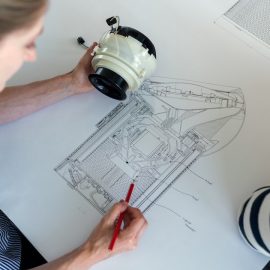

This article is an excerpt from the Shortform book guide to "Antifragile" by Nassim Nicholas Taleb. Shortform has the world's best summaries and analyses of books you should be reading.
Like this article? Sign up for a free trial here .
What’s the difference between theory vs practice? Why is it so important to understand this difference when trying to build antifragile systems?
When it comes to theory vs practice, the bottom line is that talk is cheap. Many people have good ideas, or at least know how to sell them. But when there’s no action, it’s meaningless, and just contributes to more fragility.
Read more about theory vs practice below.
Ethics and Stakes
Chapters 23 and 24 are about ethics and its connection to fragility. Specifically, they discuss modern situations where people are able to split benefit and harm—in other words, fragility and antifragility. Wealthy bankers and business executives, for instance, are often able to rake in great profits for themselves while shunting costs to the less fortunate.
Chapter 25 is the conclusion of this long essay. It starts by restating the thesis: Everything is either helped or harmed by random events and damage. It then goes on to briefly show how every point that we’ve discussed grows out of that original concept.
Asymmetry in Society
We’ve talked a lot about benefit and harm and how many situations have some of each. The trick, as we’ve said before, is to get yourself into situations where you’re likely to be benefited more than harmed.
Unfortunately, modern society especially makes it possible to give the benefits to one person or group, and the harm to another. The problem is imbalanced agency; some people have the power to make decisions that affect many others, and the others have no choice but to accept the outcomes of those decisions. Taken to the extreme, this imbalanced agency is how we end up with countries that have a handful of billionaires and millions of people in poverty.
When we say agency, what we really mean is optionality. The people who have the power are the ones who have all the options and therefore, all the antifragility. They can shunt the fragility onto those who are less powerful, generally the poor and the marginalized.
Something to Lose
The best way to correct this imbalance is by making sure that everyone has something to lose—some kind of fragility that they need to defend against. Rather than enforcing this principle with complex rules and massive enforcement agencies (remember, size and rigid controls make systems fragile), it could be addressed with simple laws. In fact, the Code of Hammurabi found an ideal solution almost four millennia ago.
One tenet in the Code stated that any injuries or deaths caused from the collapse of a house would also be inflicted on the one who built that house. If the owner of the house died, the builder would be executed; if the owner’s son died, the builder’s son would be executed, and so on.
It might sound brutal to our modern-day sensibilities, but the punishment wasn’t the point. The point was to give the builder a stake in what he was building. A craftsman knows his craft better than any government-sponsored team of safety inspectors, so this is the simplest and most effective way to make sure that what he makes is safe and of good quality.
Fat Tony has a more modern take on this issue, seen in his two rules of thumb about flying:
- Don’t get on a plane until the pilot’s onboard.
- Make sure there’s a copilot.
The first rule is about avoiding the transfer of fragility—in simpler terms, making sure the pilot has something to lose before getting on the plane yourself. The second rule goes back to redundancy—making sure there’s a backup plan in case something goes wrong anyway.
Theory vs Practice: Talk Is Cheap
One major source of fragility in our society is that we give a free pass to the talkers: the people who spread ideas but do nothing with them personally. Even if the ideas turn out to be harmful, only the people who act on those ideas face consequences—in other words, they take on the fragility of the situation. This effect is especially pronounced in the Information Age, where ideas can spread to millions of people almost instantly.
One extreme example of this transfer of fragility from the talkers to the doers can be seen in the work of New York Times journalist Thomas Friedman. His op-eds about terrorism contributed a bit to the start of the Iraq war in 2003. However, it was other people who faced the consequences of Friedman’s ideas. Friedman himself got to sit safely behind his computer and continue writing.
Many of our systems operate on punishment. For example, someone who drives drunk could face heavy penalties like fines and jail time. If the charges are severe enough, that person might never be allowed to drive again. However, for some reason, the Thomas Friedmans of the world don’t face any consequences at all.
The talkers have another advantage as well: They get the benefit of hindsight. While prediction is a notoriously unreliable art, postdiction (talking after an event has happened) makes one look infallible. It gives the chance to cherry-pick events or outright lie about them.
Given the chance, an armchair expert will tell you that he saw it coming (whatever it was). Furthermore, he’ll say that given his great track record, you’d be foolish not to listen to everything he has to say in the future. Of course, any future predictions he makes will cause the usual fragility.
Our modern preoccupation with knowledge plays into this source of societal fragility. Knowledge means talk; academics, journalists, and everyday people can just talk about their ideas and their predictions, and there’s little (if any) need to back up their statements with evidence. Winning a debate nowadays isn’t about being correct, it’s about being charismatic. The weight of an argument is measured in Facebook likes.
Like the builder in Hammurabi’s time, everyone should have a stake in what they put into the world, whether that’s concrete goods or words on paper. For example, if you write an article calling for war, you should be the first one volunteering to fight it.

———End of Preview———
Like what you just read? Read the rest of the world's best book summary and analysis of Nassim Nicholas Taleb's "Antifragile" at Shortform .
Here's what you'll find in our full Antifragile summary :
- How to be helped by unforeseen events rather than harmed by them
- Why you shouldn't get too comfortable or you'll miss out on the chance to become stronger
- Why you should keep as many options available to you as possible






